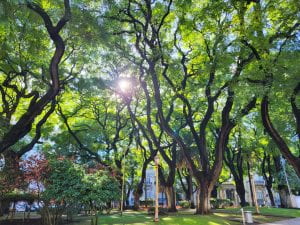
“Fucked-up states”
Dr. Mary R. Harvey notes the following in Sources and Expression of Resilience in Trauma Survivors:
“Violence, abuse, tragedy, and catastrophe know no national boundaries. Indeed, they make themselves at home in nations, cultures, homes, and communities throughout the globe.”
Seems like one of those “no shit” kinda things at first, but really take a second to think about how terms like “genocide” and “ethnic violence” carry connotation in your head. What places and people come to mind? It’s going to be different for everyone; you might think Rwanda, I think Palestine, Bill thinks Sudan, etc.
Point is, you and I will be hard pressed to find estadounidenses whose first association with these terms is with the United States and other North American states. Between 400 years of slavery, genocide, invasion, developing the framework of concentration camps, and inhumane imprisonment, the US really should be everyone’s first, at least second answer.
Despite this, we’ve been enculturated through US media (manipulated by the state/oligarchy) to perceive our conditions as anything other than indicative of genocide. We came here to Argentina learning about how the repressors used euphemisms for things like torture and execution, but what about ours?
Here are some truly US euphemisms, with some translations I’ve provided. I think I get to say at this point I’m pretty alright at translating, cause I’ve been doing it the entire time:
- “Trail of Tears” – a death march against Indigenous Americans already weakened from invasion, plague, and treachery, which forced them and their descendents to live on reservations,
- “Reservation” – an open-air prison,
- “Forfeiture of one’s 13th Amendment rights” – forcibly enslaving someone,
- “Punishable by fine” – you can get away with it if you’re rich and white,
- “Died after police believed they saw a firearm” – murdered by an occupying military force with absolute impunity.
The list can go as long as we want it to, because this is a state and cultural entity obsessed with whitewashing. Why do you think we don’t have nationally-effective unions? Can we name a single unified student political front — and for the love of the Good Lord, don’t say the Young Democrats — that is able to effect change? Why is the US so different from Argentina, and why are the people who grow up buying into the US so different from those who don’t?
THE UNITED STATES IS A PRISON. It is a machine designed to create generation after generation of apathetic and complacent citizens, accepting the divine authority of the state before anything else. Sick? It’s your fault, pay for it. Arrested? Your fault, should have known better. House seized by the state with no compensation? Your fault again, should have paid for a better lawyer.
THE UNITED STATES IS A MONSTER. It feeds off of your blood, sweat, and tears and demands more until you’re dead and can’t say no anymore. It draws diasporas with hopes of an “American Dream” which will never come: it’s the bulb in front of the anglerfish — the only one who gets to benefit from the trick is the one doing the trick. You’ll spend your whole life’s savings trying to stay afloat here. Meanwhile your money is just going to line the pockets of some rich fuck in Hell’s Kitchen, who’s gonna spend your rent on blow and sashimi tonight.
One of my classmates on this program asked “if [I] hate America so much, if it’s so bad, then why do [I] even live there?”. We could unpack that a lot, but after these weeks here I’m gonna start charging for emotional labor by the minute — for now, let’s just keep it at that. We all know what that sentence leads to, and I thought it was pretty funny considering we’re abroad and not too far from “my country:.
To respond: something I stole from some anti-Charlie Kirk meme I saw a while ago.
“You hate feudalism? Yet you toil the lord’s land. Curious.”
To sum up this post, these countries are all damned from the start. We, as estadounidenses, just find ourselves on a different, more progressed branch of imperialism/capitalism. Is there hope? I hope so! Did I learn here? Of course! Was it worth it to come here? Absolutely. Was it easy? Fuck no. Does the constant cycle of micro/MACROaggressions, interpreting, undercooked meat, and big walks take a toll on your health? Yes, next time I’ll bring more vitamin C and DayQuil.
ALHAMDULLILAH IN ANY CASE
 When leaving Buenos Aires and returning to Atlanta I felt very tired, not from lack of sleep but from information overload. I learned a lot. And, a lot of this was very depressing. It will be good to get a good night’s sleep in my own bed. Maybe tomorrow I will be better able to process the whole trip.
When leaving Buenos Aires and returning to Atlanta I felt very tired, not from lack of sleep but from information overload. I learned a lot. And, a lot of this was very depressing. It will be good to get a good night’s sleep in my own bed. Maybe tomorrow I will be better able to process the whole trip. 













